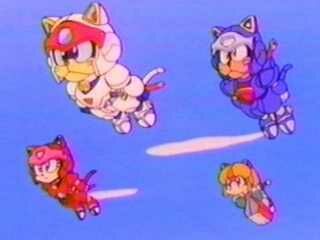| Yattaro-san wa doko ni imas' ka? * Mae *
Pururun-san wa doko ni imas' ka? *Hidari* Sukasii-san wa doko ni imas' ka? * Migi * Otama-chan wa doko ni imas' ka? *Ushiro* |
 |
 Here's how you can learn these 2 without even really trying: get a ball point pen and write "migi" on the back of your right hand, right by where your thumb is attached (it doesn't need to be big, just as long as you can read it), then write "hidari" in the same spot on your left hand. You'll have to write one of them with the hand you don't normally write with, but you can manage. After seeing these on your hands all day, by the time the ink wears off, you'll probably never forget Migi and Hidari! If something is in front of something, it's "Mae" (mah-eh), sometimes another word "Saki" (sah-kee) is used instead. This isn't the rice wine, "Sake" (sah-keh). You might also hear "Massugu saki des'"="It's right ahead". Saki also means "first", I guess because if something is in front, it's the first thing. So, now you know 3 directions. But, if you go too far, what you're looking for may be "Ushiro" (oo-shee-roh) "In back". This means something is behind something, and it's not the same as "go back" or "return", for that you'd say "Modotte kimas'" (Moh-doht-teh kee-mas)="Return/come back" or "Modotte ikmas'"="go back". (The difference between the 2 is that "kimas'" means "come" and "ikimas'" means "go")
Here's how you can learn these 2 without even really trying: get a ball point pen and write "migi" on the back of your right hand, right by where your thumb is attached (it doesn't need to be big, just as long as you can read it), then write "hidari" in the same spot on your left hand. You'll have to write one of them with the hand you don't normally write with, but you can manage. After seeing these on your hands all day, by the time the ink wears off, you'll probably never forget Migi and Hidari! If something is in front of something, it's "Mae" (mah-eh), sometimes another word "Saki" (sah-kee) is used instead. This isn't the rice wine, "Sake" (sah-keh). You might also hear "Massugu saki des'"="It's right ahead". Saki also means "first", I guess because if something is in front, it's the first thing. So, now you know 3 directions. But, if you go too far, what you're looking for may be "Ushiro" (oo-shee-roh) "In back". This means something is behind something, and it's not the same as "go back" or "return", for that you'd say "Modotte kimas'" (Moh-doht-teh kee-mas)="Return/come back" or "Modotte ikmas'"="go back". (The difference between the 2 is that "kimas'" means "come" and "ikimas'" means "go")When you're talking about where something is, you'll often need the particle "ni". "Ni" refers to a location, so it's sort of like "in", "at" or "to". So, if you were going to Tokyo, you'd say "Tokyo ni ikimas'." If you want to say that someone is in Tokyo, you'd say "Tokyo ni imasu'". "Imasu" (ee-mas) is like "arimas'", except you use it for talking about people and animals. So, to say that a thing is in Tokyo, you'd use "Tokyo ni arimas'." instead. We've already talked a little about "Doko", "Koko", "Soko" and "Asoko", but I'll review them again now. "Doko" is the question word, "where", "Doko des' ka?"="Where is it?". "Koko" means "Here", "Koko des'"="It's here", "Soko" is "There", referring to near the person you're talking to, and "Asoko" is "There", referring to something away from you and the person you're talking to. It's the same pattern as "Kore", "Sore", and "Are".
Let's practice!
The migi and hidari in the questions refers to your right and left, not the cats in the picture's right and left. And in case you're not an expert in the Japanese version of Pizza Cats, Yattaro is the cat in white, Pururun is the cat in red, Sukashii is the cat in blue, and Otama is the one in green. Drag your mouse between the stars to check your answer.
| Yattaro-san wa doko ni imas' ka? * Mae *
Pururun-san wa doko ni imas' ka? *Hidari* Sukasii-san wa doko ni imas' ka? * Migi * Otama-chan wa doko ni imas' ka? *Ushiro* |
 |